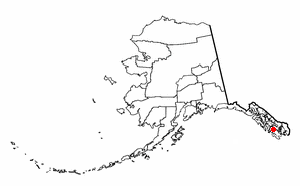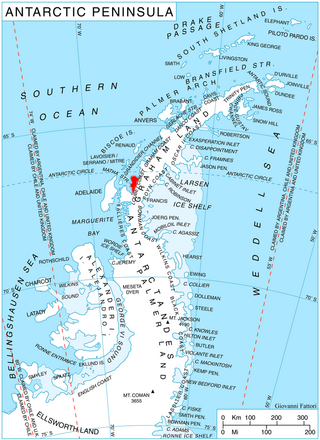
The Arctic Archipelago, also known as the Canadian Arctic Archipelago, is an archipelago lying to the north of the Canadian continental mainland, excluding Greenland and Iceland.

Naukati Bay is a census-designated place (CDP) in the Prince of Wales-Hyder Census Area of the Unorganized Borough of the U.S. state of Alaska. The population was 113 at the 2010 census, down from 135 in 2000.

Palmer Land is the portion of the Antarctic Peninsula, Antarctica that lies south of a line joining Cape Jeremy and Cape Agassiz. This application of Palmer Land is consistent with the 1964 agreement between the Advisory Committee on Antarctic Names and the UK Antarctic Place-Names Committee, in which the name Antarctic Peninsula was approved for the major peninsula of Antarctica, and the names Graham Land and Palmer Land for the northern and southern portions, respectively. The line dividing them is roughly 69° S.

The Prince Charles Mountains are a major group of mountains in Mac. Robertson Land in Antarctica, including the Athos Range, the Porthos Range, and the Aramis Range. The highest peak is Mount Menzies, with a height of 3,228 m (10,591 ft). Other prominent peaks are Mount Izabelle and Mount Stinear. These mountains, together with other scattered peaks, form an arc about 420 km (260 mi) long, extending from the vicinity of Mount Starlight in the north to Goodspeed Nunataks in the south.
The Scott Mountains are a large number of isolated peaks lying south of Amundsen Bay in Enderby Land of East Antarctica, Antarctica. Discovered on 13 January 1930 by the British Australian New Zealand Antarctic Research Expedition (BANZARE) under Sir Douglas Mawson. He named the feature Scott Range after Captain Robert Falcon Scott, Royal Navy. The term mountains is considered more appropriate because of the isolation of its individual features.

Interstate 35W (I-35W), an Interstate Highway, is the western half of I-35 where it splits to serve the Dallas–Fort Worth metropolitan area. I-35 splits into two branch routes, I-35W and I-35E, at Hillsboro. I-35W runs north for 85.2 miles (137.1 km), carrying its own separate sequence of exit numbers. It runs through Fort Worth before rejoining with I-35E to reform I-35 in Denton. It is the more direct route for long-distance expressway traffic, as is noted on signs on I-35 leading into the I-35W/I-35E splits. During the 1970s, billboards existed on I-35 encouraging travelers to take the faster and shorter I-35W route.
The Scaled Composites Model 133-4.62 ATTT, or Advanced Technology Tactical Transport was a technology demonstration project built by Burt Rutan's Scaled Composites in 1986 under contract to DARPA.

The Bücker Bü 133 Jungmeister was an advanced trainer of the Luftwaffe in the 1930s. It was a single-engine, single-seat biplane of wood and tubular steel construction and covered in fabric.
The 2007 PartyBets.com Premier League was a professional non-ranking snooker tournament that was played from 6 September to 2 December 2007.

The Pratt & Whitney T34 was an American axial flow turboprop engine designed and built by Pratt & Whitney. Its only major application was on the Douglas C-133 Cargomaster.
Pozo de la Piedra is a town and municipality in Catamarca Province in northwestern Argentina.
Armstrong Glacier is a glacier flowing from the south side of Mount Bagshawe westward into George VI Sound. It provides the only known safe route for mechanical vehicles from George VI Sound to the Palmer Land plateau. It was named by the United Kingdom Antarctic Place-Names Committee for Edward B. Armstrong, British Antarctic Survey surveyor at Stonington Island, 1964–65.

The Dawson-Lambton Glacier is a heavily crevassed glacier entering the south-eastern Weddell Sea immediately west of the Brunt Ice Shelf. It was discovered in January 1915 by a British expedition led by Ernest Shackleton. He named it for Elizabeth Dawson-Lambton, a benefactress of the Shackleton expeditions.

Field Glacier is a glacier on Pernik Peninsula, Loubet Coast in Graham Land, situated south of Salmon Cove, and flowing west into Lallemand Fjord just south of Kanchov Peak. It was mapped from air photos taken by the Falkland Islands and Dependencies Aerial Survey Expedition, 1956–57. In association with the names of glaciologists grouped in this area, it was named by the UK Antarctic Place-Names Committee after William B.O. Field, an American glaciologist and surveyor, sometime Research Fellow of the American Geographical Society.
German submarine U-608 was a Type VIIC U-boat of Nazi Germany's Kriegsmarine during World War II. During the Battle of the Atlantic, she was commanded by Kapitänleutnant Rolf Struckmeier as a unit of Wolfpack Vorwärts.
German submarine U-133 was a Type VIIC U-boat built for Nazi Germany's Kriegsmarine for service during World War II. She was laid down on 21 August 1940 by Vegesacker Werft, Bremen-Vegesack as yard number 12, launched on 28 April 1941 and commissioned on 5 July that year. U-133 sank with all hands lost after striking a mine off Aegina island Greece on 14 March 1942. In 1986 the professional divers Efstáthios "Státhis" Baramátis and Theófilos Klímis spotted by chance a wreck at a depth of 74 meters that was identified as an unknown German submarine. Almost ten years later, in the mid-90s, the same wreck was further identified by Greek divers as the U-133.
German submarine U-623 was a Type VIIC U-boat built for Nazi Germany's Kriegsmarine for service during World War II. She was laid down on 15 July 1941 by Blohm & Voss, Hamburg as yard number 599, launched on 31 March 1942 and commissioned on 21 May 1942 under Oberleutnant zur See Hermann Schrüder.
German submarine U-291 was a Type VIIC U-boat of Nazi Germany's Kriegsmarine during World War II.

German submarine U-776 was a Type VIIC U-boat of Nazi Germany's Kriegsmarine during World War II.









